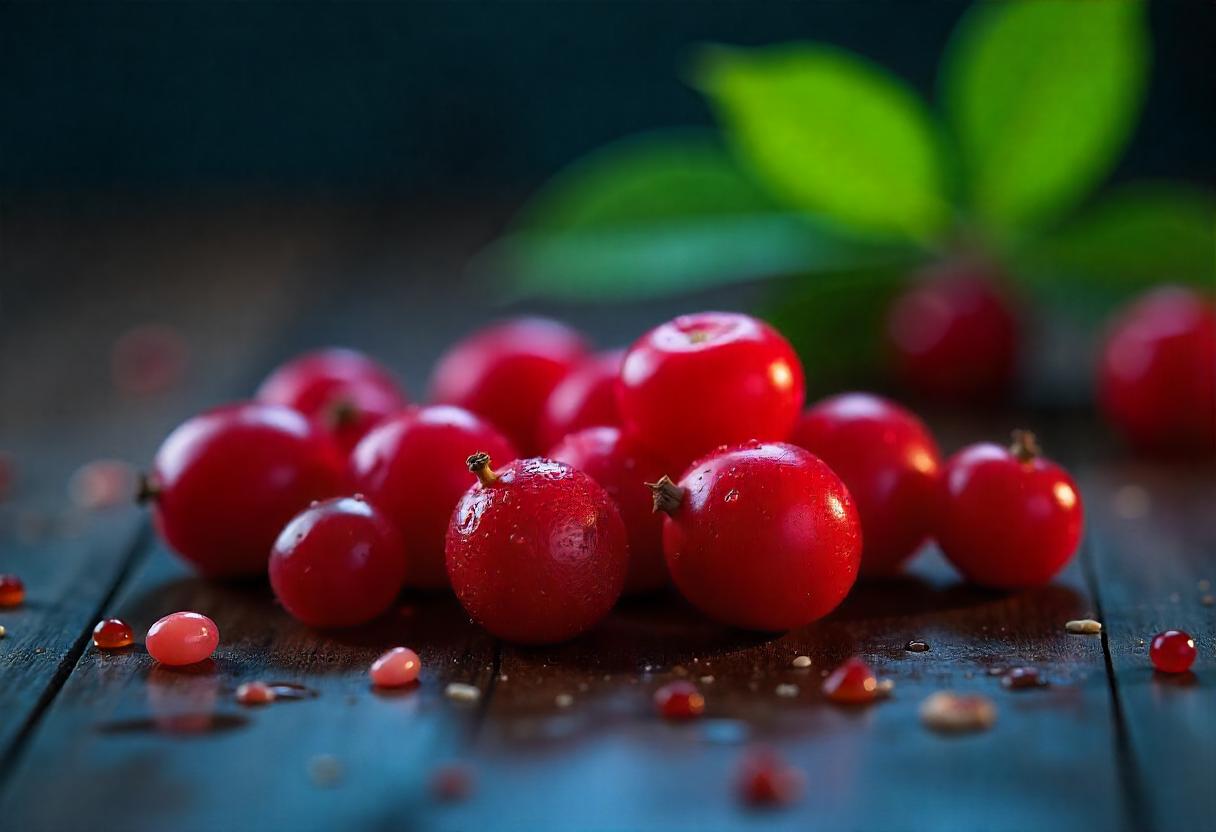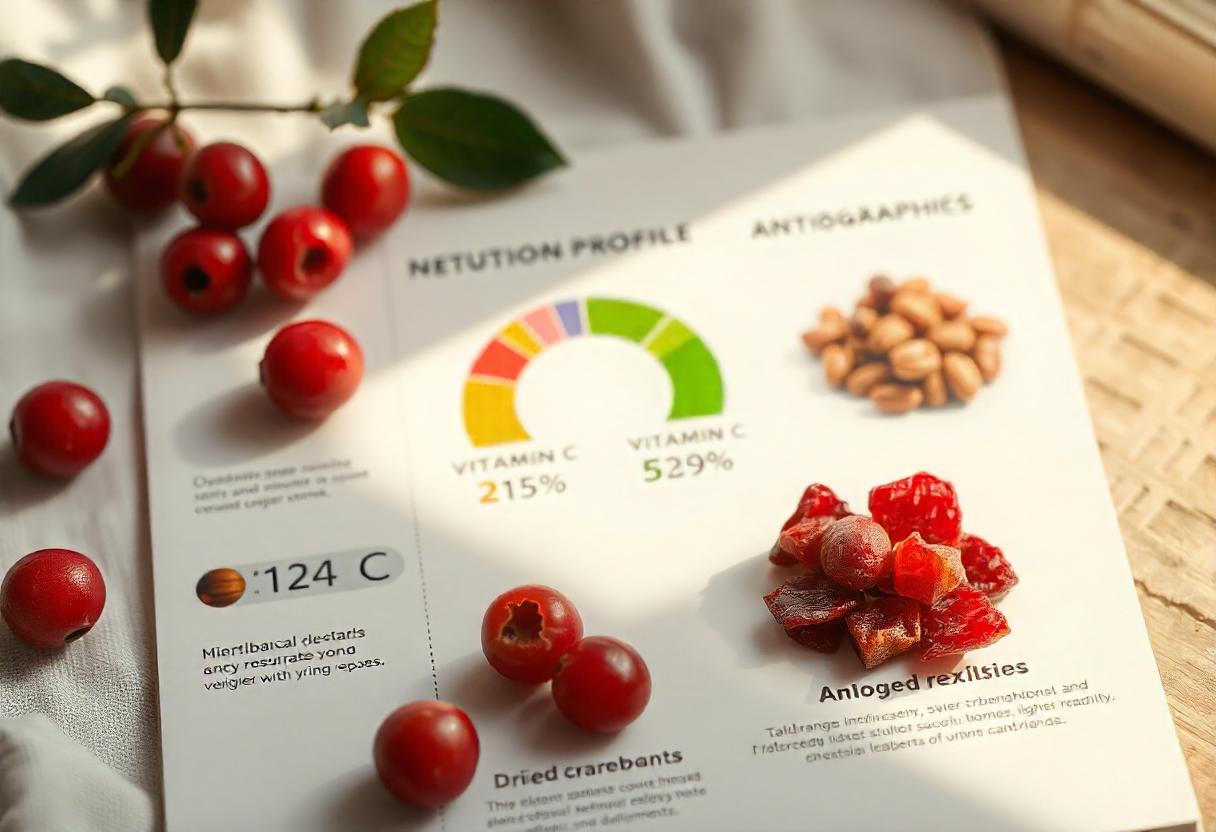
Cranberries, small red berries known for their tart flavor, have garnered attention for their numerous health benefits and culinary versatility. These berries, belonging to the family Ericaceae, are primarily found in North America, flourishing in acidic, sandy soils. Whether enjoyed fresh, dried, or in juice form, cranberries pack a powerful punch of flavor and nutrition. From supporting urinary health to offering a rich supply of antioxidants, cranberries are a nutritional powerhouse. This article will explore what cranberries are, their myriad benefits, common myths surrounding them, cooking methods, tips for growing them, and their cultural significance.
What Are Cranberries?
Cranberries are small, round berries that grow on low-lying vines in sandy bogs and marshes. These vibrant red berries are native to North America and have been a staple in Indigenous diets for centuries. Known for their unique tart flavor, cranberries are not only delicious but also loaded with nutrients and health benefits, making them a popular choice in both savory and sweet dishes.
Botanical Characteristics
Cranberries belong to the genus Vaccinium, which includes other berries like blueberries and huckleberries. There plant is a perennial evergreen shrub that can reach up to 7 feet in length. The plant produces pink or white flowers that develop into the well-known red fruit. The most common variety is the American cranberries (Vaccinium macrocarpon), which thrives in regions with cold winters and wet, acidic soils.
Health Benefits of Cranberries
Cranberries offer a range of health benefits, making them a great addition to your diet. Here are some of the most significant advantages:
1. Urinary Health
One of the most well-known benefits of cranberries is their role in promoting urinary tract health. The compounds in cranberries can help prevent bacteria from adhering to the urinary tract walls, reducing the risk of infections. This has led to popular searches for terms like “cranberry juice for UTI” and “are cranberries good for urinary health?” The active compounds, particularly proanthocyanidins, are responsible for this protective effect.
2. Rich in Antioxidants
Cranberries are packed with antioxidants, which help combat oxidative stress and inflammation in the body. This can lower the risk of chronic diseases and improve overall health. The antioxidants found in cranberries, including flavonoids, phenolic acids, and vitamin C, contribute to their ability to protect cells from damage.
3. Heart Health
Regular consumption of cranberries may help reduce the risk of heart disease by lowering blood pressure, improving cholesterol levels, and supporting overall cardiovascular health. Studies have shown that cranberries can reduce LDL cholesterol levels and increase HDL cholesterol, the “good” cholesterol, promoting better heart function.
4. Weight Management
Low in calories and high in fiber, cranberries can be a valuable addition to weight management plans. Their natural sweetness makes them a great alternative to high-calorie snacks, and their fiber content can help promote feelings of fullness, reducing overall calorie intake.
5. Skin Health
The antioxidants in cranberries can also promote healthy skin by combating the effects of aging and UV damage. They can help reduce redness and irritation, making cranberries beneficial for skin conditions like acne or eczema. The presence of vitamin E in cranberries aids in maintaining skin moisture and elasticity.
6. Cancer Prevention
Some studies suggest that the compounds found in cranberries may have protective effects against certain types of cancer, including breast and colon cancer. The antioxidants in cranberries can inhibit cancer cell growth and promote apoptosis (programmed cell death) in malignant cells, potentially reducing the risk of cancer development.
7. Blood Sugar Control
Cranberries may help regulate blood sugar levels, making them a beneficial addition to the diets of those with diabetes. Some studies indicate that the compounds in cranberries can improve insulin sensitivity and lower blood sugar levels, making them a suitable fruit choice for people managing diabetes.
8. Digestive Health
Cranberries can contribute to digestive health as well. The fiber content aids in regular bowel movements and helps maintain a healthy gut microbiome. The anti-inflammatory properties of cranberries can also support digestive health by reducing inflammation in the gut.
Nutritional Profile of Cranberries

Understanding the nutritional content of cranberries can help you appreciate their benefits even more. Here’s a breakdown of the nutrients found in a one-cup serving of fresh cranberries:
- Calories: 46
- Carbohydrates: 12 grams
- Fiber: 4 grams
- Protein: 0.4 grams
- Fat: 0.1 grams
- Vitamins: High in Vitamin C (24% of the daily value), Vitamin E, and Vitamin K
- Minerals: Contains manganese, copper, and potassium
This nutritional profile reinforces the value of incorporating cranberries into your diet, whether in the form of fresh cranberries, dried cranberries, or Juice.
Common Myths About Cranberries
There are many misconceptions about cranberries. Here are some common myths and the facts that clarify them:
Myth 1: Cranberries Are Only Good for Preventing Urinary Tract Infections
Fact: While cranberries are beneficial for urinary health, they also support heart health, skin health, and may aid in cancer prevention. Their rich antioxidant content contributes to various health benefits beyond just urinary tract support.
Myth 2: All Cranberries Juice Is Healthy
Fact: Many commercially available juices are loaded with sugar and lack the beneficial compounds found in whole cranberries. Opt for 100% juice or make your own at home for the best health benefits.
Myth 3: Dried Cranberries Are Just as Healthy as Fresh Cranberries
Fact: Dried cranberries often contain added sugars, which can diminish their health benefits. Look for unsweetened varieties to get the most nutrients and health advantages from cranberries.
How to Cook with Cranberries
Cranberries can be used in various cooking methods, adding flavor and nutrition to a wide range of dishes. Here are some popular recipes:
1. Homemade Juice
Ingredients:
- 2 cups fresh cranberries
- 4 cups water
- Sugar or sweetener to taste (optional)
Steps:
- Rinse the cranberries under cold water to clean them.
- In a large pot, combine the cranberries and water.
- Bring to a boil, then reduce heat and simmer for about 10-15 minutes until the berries burst.
- Strain the mixture through a fine mesh sieve or cheesecloth to separate the juice from the solids.
- Sweeten the juice to taste and chill before serving.
Taste Description: Homemade juice has a refreshing tartness balanced with sweetness, making it a revitalizing drink that’s great on its own or mixed with other juices.
2. Sauce
Ingredients:
- 2 cups fresh cranberries
- 1 cup sugar (adjust to taste)
- 1 cup orange juice (freshly squeezed for best flavor)
- Optional: zest of 1 orange, a pinch of cinnamon
Steps:
- Rinse the cranberries and place them in a saucepan.
- Add sugar and orange juice to the pot and bring to a boil.
- Reduce the heat and simmer for about 10-15 minutes, stirring occasionally, until the cranberries burst and the sauce thickens.
- Allow the sauce to cool before serving.
Taste Description: There sauce is a delightful blend of sweet and tart flavors. The addition of orange juice enhances its citrus notes, making it a classic pairing for savory dishes, especially during holiday meals.
3. Salad
Ingredients:
- 1 cup fresh cranberries
- 4 cups mixed greens (spinach, arugula, etc.)
- 1/2 cup nuts (walnuts or pecans)
- 1/4 cup feta cheese (optional)
- 1/4 cup vinaigrette dressing
Steps:
- Rinse and chop the fresh cranberries.
- In a large bowl, combine mixed greens, cranberries, nuts, and feta cheese.
- Drizzle with vinaigrette dressing and toss gently to combine.
Taste Description: This salad offers a vibrant contrast of flavors and textures. The tart cranberries complement the creamy feta and crunchy nuts, creating a refreshing dish that’s both nutritious and satisfying.
4. Muffins
Ingredients:
- 1 1/2 cups all-purpose flour
- 1/2 cup sugar
- 1/2 cup butter (melted)
- 1 cup fresh or dried cranberries
- 2 large eggs
- 1/2 cup milk
- 1 tsp baking powder
- 1/2 tsp baking soda
- 1/2 tsp salt
Steps:
- Preheat the oven to 375°F (190°C) and grease a muffin tin.
- In a bowl, mix flour, sugar, baking powder, baking soda, and salt.
- In another bowl, whisk together melted butter, eggs, and milk.
- Combine the wet and dry ingredients, then fold in the cranberries.
- Spoon the batter into the muffin tin and bake for 20-25 minutes or until golden.
Taste Description: There muffins are delightfully moist, with a lovely balance of sweetness and tartness. The tart cranberries create a pleasant contrast to the sweet muffin base, making them a perfect breakfast treat.
5. Brie Bites
Ingredients:
- 1 sheet puff pastry (thawed)
- 1 cup cranberry sauce
- 8 oz brie cheese (cut into small pieces)
- Fresh thyme or rosemary (for garnish)
Steps:
- Preheat the oven to 400°F (200°C).
- Roll out the puff pastry and cut it into small squares (about 3×3 inches).
- Place the pastry squares in a greased muffin tin.
- Add a spoonful of cranberry sauce and a piece of brie cheese to each pastry square.
- Bake for 15-20 minutes until golden brown and puffed.
- Garnish with fresh herbs before serving.
Taste Description: These bite-sized appetizers offer a rich, creamy texture from the brie, complemented by the sweet and tart cranberry sauce. The flaky pastry adds a delightful crunch, making them irresistible at gatherings.
6. Orange Sauce
Ingredients:
- 2 cups fresh cranberries
- 1 cup orange juice
- 1 cup sugar (to taste)
- Optional: zest of 1 orange
Steps:
- Rinse the cranberries and place them in a saucepan.
- Add orange juice, sugar, and orange zest (if using).
- Bring to a boil, then simmer for 10-15 minutes until thickened.
Taste Description: The bright citrus notes of orange enhance the natural tartness of cranberries, creating a vibrant sauce that pairs beautifully with poultry and pork dishes.
7. Relish
Ingredients:
- 2 cups fresh cranberries
- 1 cup sugar
- Zest of 1 orange
Steps:
- Rinse and chop the cranberries.
- In a bowl, combine chopped cranberries, sugar, and orange zest.
- Mix well and let sit for at least 30 minutes before serving to meld flavors.
Taste Description: Relish offers a zesty, fresh taste with a sweet crunch, making it an excellent accompaniment to roasted meats and sandwiches.
8. Vodka Cocktail
Ingredients:
- 1 cup cranberry juice
- 2 oz vodka
- 1 oz lime juice
- Ice
- Lime slices for garnish
Steps:
- In a shaker, combine cranberry juice, vodka, and lime juice with ice.
- Shake well and strain into a glass filled with ice.
- Garnish with lime slices before serving.
Taste Description: This cocktail is refreshing and slightly tart, with the vodka adding a smooth finish. The cranberry juice provides a beautiful color and a delightful flavor.
9. Cake
Ingredients:
- 2 cups all-purpose flour
- 1 cup sugar
- 1 cup butter (softened)
- 2 large eggs
- 1 cup fresh or dried cranberries
- 1 tsp baking powder
- 1/2 tsp salt
Steps:
- Preheat the oven to 350°F (175°C) and grease a cake pan.
- In a bowl, cream together the butter and sugar.
- Add eggs one at a time, mixing well after each addition.
- Gradually mix in flour, baking powder, and salt.
- Fold in cranberries and pour the batter into the prepared pan.
- Bake for 30-35 minutes until golden and a toothpick comes out clean.
Taste Description: There cake is moist and flavorful, with the tartness of the cranberries perfectly balanced by the sweetness of the cake, making it an excellent dessert option.
10. Scones
Ingredients:
- 2 cups all-purpose flour
- 1/2 cup sugar
- 1/2 cup butter (cold and cubed)
- 1 cup fresh or dried cranberries
- 1/2 cup milk
- 1 egg
- 1 tbsp baking powder
- 1/2 tsp salt
Steps:
- Preheat the oven to 400°F (200°C) and line a baking sheet with parchment paper.
- In a bowl, mix flour, sugar, baking powder, and salt.
- Cut in the butter until the mixture resembles coarse crumbs.
- Stir in cranberries.
- In another bowl, whisk together milk and egg, then add to the dry ingredients, mixing until just combined.
- Drop spoonfuls of dough onto the baking sheet and bake for 15-20 minutes until golden.
Taste Description: There scones are light and fluffy, with bursts of tart cranberries throughout. They are delightful when served warm, perfect for breakfast or afternoon tea.
11. White Chocolate Cookies
Ingredients:
- 2 cups all-purpose flour
- 1/2 cup sugar
- 1/2 cup brown sugar
- 1/2 cup butter (softened)
- 1 cup cranberries (fresh or dried)
- 1 cup white chocolate chips
- 1 egg
- 1 tsp baking soda
- 1/2 tsp salt
Steps:
- Preheat the oven to 350°F (175°C) and line a baking sheet with parchment paper.
- In a bowl, cream together butter, sugar, and brown sugar.
- Beat in the egg until combined.
- Gradually mix in flour, baking soda, and salt, then fold in cranberries and white chocolate chips.
- Drop spoonfuls of dough onto the baking sheet and bake for 10-12 minutes until edges are golden.
Taste Description: These cookies combine the tartness of cranberries with the sweetness of white chocolate, creating a delightful balance. They are chewy and rich, making them a favorite treat.
How to Grow Cranberries
Growing cranberries can be a rewarding endeavor. Here are some tips to help you get started:
Suitable Conditions
Cranberries thrive in acidic, sandy soil with good drainage. They require full sun and can benefit from a consistent water supply. Ensure that the planting area has sufficient space for the plants to spread.
Planting
Plant cranberries in early spring. Choose healthy, disease-free plants, and space them appropriately to allow for growth. It’s best to plant cranberries in beds that are raised to improve drainage.
Care
Regular watering is essential, especially during dry spells. Mulching can help retain moisture and suppress weeds. Fertilizing with a balanced fertilizer can also promote healthy growth.
Harvesting
Cranberries are typically harvested in the fall when they are fully ripe. Flooding the bogs makes it easier to gather the floating berries. This unique harvesting method is part of what makes cranberry farming so distinctive.
Where to Buy Fresh Cranberries
Purchase fresh cranberries online, directly from Cape Cod’s famous bogs. They offer seasonal berries, sauces, and products that are shipped across the U.S.
1. Online Stores
- Wisconsin Cranberries Growers Association
- Offers direct online sales, shipped fresh from Wisconsin’s renowned bogs. Find a variety of options from bulk berries to jams and juices.
- Cape Cod Growers’ Association
- Purchase fresh produce online from Cape Cod’s famous bogs, including seasonal berries, sauces, and other products shipped across the U.S.
- B.C. Growers Association
- British Columbia’s Growers Association allows online orders during harvest, providing high-quality berries from one of Canada’s largest producers.
2. Farmers' Markets and Festivals
- Wisconsin Farmers’ Markets, Wisconsin, USA
- Local markets, especially during the harvest season, offer fresh produce from nearby farms. Wisconsin also hosts festivals with a range of berry-themed products.
- Bala Festival, Ontario, Canada
- Ontario’s Muskoka region hosts a festival with a farmers’ market atmosphere, featuring local produce and berry-based goods—a must-visit for berry enthusiasts in Canada.
- P.E.I. Local Markets, Prince Edward Island, Canada
- Known for organic, eco-friendly options, local farms in Prince Edward Island sell fresh berries directly at their markets.
3. Local Grocery Stores and Specialty Shops
- Whole Foods Market (Nationwide, U.S. & Canada)
- Fresh, seasonal berries are available in Whole Foods stores across North America, featuring locally sourced and organic options.
- Trader Joe’s (U.S.)
- Known for its specialty products, Trader Joe’s offers seasonal fresh and berry-based items, especially around the holidays.
- Loblaws and Sobeys (Canada)
- In Canada, Loblaws and Sobeys stock fresh berries in their produce sections, particularly around fall and winter.
4. Directly from Farms
The Lady, Tasmania, Australia
Australian consumers can purchase fresh, seasonal produce from The Cranberry Lady, a farm specializing in sustainable practices with direct sales to customers.Wisconsin Bog Farms, Wisconsin, USA
Many farms in Wisconsin offer direct sales, especially during the harvest season, providing freshly picked berries directly to visitors.Cape Cod Bogs, Massachusetts, USA
Cape Cod farms provide direct purchase options, allowing visitors to buy freshly harvested berries during the fall.
Festivals and Cultural Significance
Cranberries hold cultural significance in many regions, particularly in North America. festivals celebrate the harvest and highlight the culinary uses of this beloved fruit. These festivals often feature tastings, cooking demonstrations, and community activities, allowing people to come together to enjoy and learn about cranberries.
In addition to their culinary use, cranberries have a long history in Indigenous cultures. Native Americans used cranberries for food, medicine, and dye. The berries were also an important part of their trade systems and were used in various traditional dishes.
Conclusion
Cranberries are more than just a delicious fruit; they are a nutritional powerhouse with numerous health benefits. From promoting urinary health to supporting heart health, these berries are a fantastic addition to any diet. Their versatility in the kitchen allows for endless culinary possibilities, making them a popular choice in both sweet and savory dishes.
By incorporating cranberries into your meals and understanding their cultural significance, you can fully appreciate the marvel that is the cranberries. Whether you enjoy them fresh, dried, or in juice form, these little berries pack a big punch of flavor and nutrition.
Frequently Asked Questions (FAQs)
Cranberries are small, tart, red berries that grow on low-lying vines in wetlands and are commonly used in sauces, juices, and baked goods.
The word “cranberry” translates to “żurawina” in Polish.
“Cranberry” is pronounced as /ˈkrænˌbɛri/.
Cranberry-pills are often taken for their potential benefits in supporting urinary tract health and preventing infections. They may also help with kidney function.
Yes, cranberries can be beneficial for dogs in moderation, as they contain antioxidants and may support urinary health.
Cranberries can be used in various dishes such as sauces, desserts, salads, and beverages. They pair well with both sweet and savory ingredients.
Cranberries are low in calories and high in vitamins C, E, and K, as well as dietary fiber. They also contain antioxidants that promote overall health.
To make cranberry-sauce, simmer fresh cranberries with sugar and water until they burst and thicken. You can add orange zest or spices for extra flavor.
Cranberries are commonly thought to help prevent UTIs, as they contain compounds that may prevent bacteria from adhering to the urinary tract walls.
Fresh cranberries can be stored in the refrigerator in a sealed bag or container for up to a month. They can also be frozen for longer storage.
Popular recipes include cranberry sauce, cranberry muffins, cranberry juice, and cranberry salad.
Yes, cranberries are rich in antioxidants, which help protect the body from oxidative stress and may reduce the risk of chronic diseases.
Cranberry juice is often consumed for its health benefits, including supporting urinary tract health and providing vitamin C.
Yes, raw cranberries can be eaten, but they are quite tart. Many people prefer them cooked or sweetened.
Cranberries are native to North America and have been used by Indigenous peoples for centuries for food and medicinal purposes.
Recipes include cranberry sauce, cranberry bread, cranberry smoothies, and cranberry-infused drinks.
Fresh cranberries are naturally low in sugar; however, many commercial cranberry products, like juice and sauces, often contain added sugars.
- Cranberries are typically harvested using a method called flooding, where fields are flooded with water, and the berries are dislodged from the vines.
Cranberries season generally runs from late September through early November, which is when they are harvested.
Final Thoughts
As we explore the benefits, culinary uses, and cultural significance of cranberries, it’s essential to remember their place in our diets and traditions. So next time you reach for that bag of cranberries, consider the health benefits and delicious possibilities that await you.
By keeping this guide in mind, you can embrace the full potential of cranberries and enjoy their contributions to your health and culinary adventures. Happy cooking!



